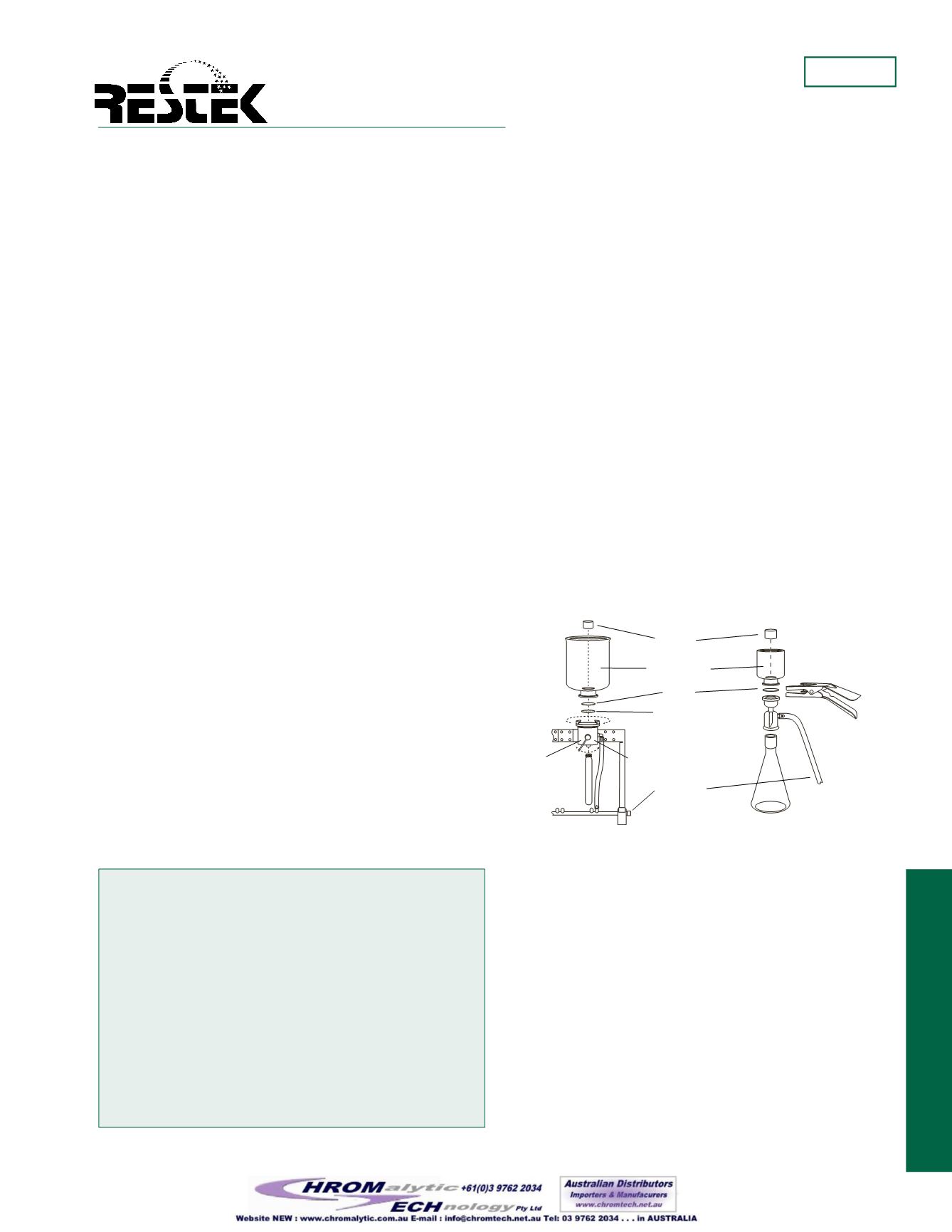
environmental
Applications
note
RestekCorporation • (800)356-1688 • (814)353-1300 •
#59544
environmental
List ofMaterials:
Disk (cat.# 26022); Filter (cat.# 26024); Manifolds (cat.#s
26025, 26026, 26027); Dry Prep (cat.#s 26075, 26076);
25mm Filter (cat.# 26073). If using glass filter beads, see
end
note
for procedural modifications.
Sample Preparation:
1.
Adjust sample to pH 2.0 with 6NHCl
2.
If sample is high in suspended solids, allow solids to
settle. When adding the sample, tilt the sample
container to allow particulates to settle on one side.
This is suggested to aid in the decanting of the liquid
portion of the sample.
ExtractionDiskConditioning:
Proper disk conditioning is critical for a successful extrac-
tion. Conditioning provides a good interface between the
sorbent and the sample matrix. Failure to condition the disk
properly may result in erratic and low recoveries.
1.
Place disk on manifold, ripple side up. Connect
reservoir securely to disk base.
2.
Place the Resprep
™
Flow Filter in the bottom of
the reservoir, flush with the edge of the glass.
3.
Wash the disk with 25mL of n-hexane.
Note:
Always run solvents down the sides of the
glassware when washing or eluting. Apply a light
vacuum (~5in. Hg) and pull approximately 1mL
through the disk. Vent the vacuum and allow the
disk to soak for 2 minutes.
4.
Apply vacuum to pull the remaining solvent
through the disk. Allow the disk to dry.
Extraction of Oil and Grease fromWastewater
Using US EPA Method 1664 and Resprep™
Oil and Grease SPE Disks and Flow Filters
Increasing environmental concerns about the effects of
released chlorofluorocarbons (CFCs) in the atmosphere, and
in an effort to reduce discharges during routine laboratory
procedures, the US Environmental Protection Agency (EPA)
has mandated the elimination of Freon
®
(CFC-113) extrac-
tion solvent for industrial waste samples. This has recently
resulted in the release of an alternative procedure for US EPA
Method 413.1—the US EPAMethod 1664, Oil and Grease
Analysis in Wastewater. The updated method describes an
n
-hexane liquid-liquid extraction and allows use of alter-
native extraction and concentration techniques such as SPE
if the performance specifications of the method are not met.
The
n
-hexane extraction process has several difficulties. As
with all liquid-liquid extractions, emulsions are problematic.
With industrial discharge samples, this problem may become
extreme and result in poor sample partitioning or samples
too viscous to process at all. Because
n
-hexane is lighter
than water, it makes routine separatory funnel processes
difficult to perform. Fortunately, some of these difficulties
may be overcome using the SPE procedure.
By decanting the supernatant from the sample first and using
an appropriate prefilter, most complex samples can be
extracted in less than an hour. The SPE system also can be
automated using vacuum manifolds. This allows simulta-
neous processing of up to six samples, thereby improving
sample throughput and lab efficiency.
The following instructions are general guidelines for SPE
extraction of oil and grease from wastewater. Sample
volume, solvent type, pH adjustment, and conditioning may
be changed to adapt to specific methods as needed.
Please note:
Thismethod is based on the US
EPAMethod 1664, but is not intended to replace
or substitute the method.
Please refer directly to the published EPA
method for additional information for the prepara-
tion of samples to be analyzed according to EPA
Method 1664.
EPA methods are available from NTIS (National
Technical Information Service), U.S. Department
of Commerce, Springfield, VA 22161, phone:
(703) 487-4650.
Option 1: Vacuum
Manifold
Option 2: Filtration
Apparatus
Flow
Filter
Disk
Vacuum
Reservoir
Wash
Screen
Elute


